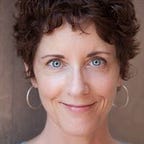A Year at McGuffey’s: A Body of Work, Everyday Distractions and…Squirrel!
When Ben returned from India in January, he brought with him half a suitcase of stunning silk remnants, trimmings and buttons. At the time I thought I might use the fabric and findings to make drawstring bags embellished with embroidery and beading. But I overestimated my machine sewing skillset and underestimated the difficulty in manipulating the slippery, fraying nature of silk. And so the fabric was neatly folded and stacked in a basket while I waited, frustrated and disappointed, for my ability to catch up to the demands of the material.
Instead I satisfied my creative itch with coiled basketry and hand stitching. I made a few kumihimo braids and continued to play with image transfers. I tripped from one technique to another like a dog uncertain of which squirrel to chase. Yesterday I attended a fantastic encaustic workshop with Karen Eide at McGuffey Art Center and I’m considering an online weaving course through Fiber Arts Takes Two with Harriet Goodall that begins in September.
All squirrels. Wonderful, fun, enlightening, creative squirrels. Squirrels that might be useful as I press forward. Or they might sploot and cool down my fevered creative energy. If there was a way to ignore the squirrels — the distractions — in order to stay focused, less impulsive and more intentional I don’t know it it would be useful. Maybe the distractions are good — even the splooting squirrel distractions.
But over the next eleven months, as one of six Incubator Artists at McGuffey’s, I need to create a cohesive body of work as part of our final group exhibit in June 2024. With that in mind, do I need to stop chasing squirrels?
An artist’s body of work traces in color, form, line and texture the artist’s creative journey. Piet Mondrian is a good example. You know him for his iconic red, yellow and white grid paintings. Maybe his Broadway Boogie Woogie. But look at his earliest paintings of trees. Or his gingerpot. And we begin to see the process. The conviction. The exploring and the questioning.
An artist’s body of work can also be a gathering together of color, form, line and texture that contains the artist’s creative response to a chosen theme, specific experience or period of time. A reflection of sorts. An epilogue. Kansas City artist Mark Kielkulki is a good example. His works on paper are grouped almost as chapters in the story of his painting life. At the same time, when you look at his overall body of work, no matter how many themes he chooses to explore, there are underlying motifs that speak to isolation, Tim Burton-esque oddities and shifting perspectives.
Thirty years ago I created a series of manipulated photographs based on Milan Kundera’s The Unbearable Lightness of Being. Later I created another series featuring Jim Morrison of The Doors and the Fourteen Stations of the Cross. I was young and cocky, insecure and envious. I was in a race against time and a duel to the death with every other young artist. I was desperate to look the part of the artist, more interested in the external experience and eager to provoke. I’m grateful that, as far as I know, this work no longer exists.
Because this time around feels different. I want my body of work to evoke. Not provoke. I don’t care what I look like and I’m eager to encourage rather than envy the five other much younger women who are will be my studio-mates this year.
I’m looking inward, not outward, this time. Maybe that’s why I should embrace the squirrels who come along to distract me. They offer me moments of peace. Of reflection.
They give me space to consider the story I want to tell in the body of work I am creating.
